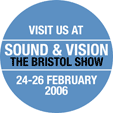|
No crossover circuit.
In the resolution SUHTL, there is no added circuitry to the drive units. speaker cables run direct to the woofer.cone, and pass through an inbuilt capacitor to the tweeters. If the capacitor was not there it would burn out the tweeters playing bassy DC-like frequencies the small coils would otherwise not block.
The capacitor acts as a 90 degree phase shift, which is mainly compensated by the forward time-aligned position of those tweeters.
What is a crossover - several people get angrily wrong about this definition. A Crossover is not a circuit, it is a feature of overlapping response by two different transducers (cones). if the cones do not overlap, there is no such thing as a crossover. if they do, then interference should occur between them. to reduce this interference, most manufacturers add a circuit which mainly reduces the amount of overlap by attenuating and phase-shifting (messing around and adulterating fidelity). this is important where the path differences would interfere at the listener, but irrelevant otherwise.
The SUHTL path difference is generally less than 1cm so is irrelevant, this is achieved by having all cones closely spaced and time-aligned. Conventional designs separate by several inches causing audible interference from overlapping frequencies of different cones.
So although the SUHTL has crossover characteristics (overlapping cone responses) it does not need a crossover circuit to reduce an audible interference it does not have.
What does circuit mean? (corssover circuit)
if your want to split hairs, ever atom has a circuit so every piece of wire is a circuit. many people feel that a capacitor constitutes a circuit, but in reality also two cones in parralell are a circuit with time/energy storing/releasing lag/leads. Where do we draw the line?
Sensibly, a crossover circuit, is only such, if it is a purposely designed and added set of time-dependent components(capacitors and inductors) that is attached to the drive units. The SUHTL does not have one of these.
The important thing, is to realise that eliminating crossover interference is good, added circuitry is bad, and SUHTL does both of these particularly well.
|


